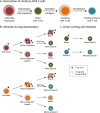Cellular and molecular mechanisms involved in the establishment of HIV-1 latency
- PMID: 23375003
- PMCID: PMC3571915
- DOI: 10.1186/1742-4690-10-11
Cellular and molecular mechanisms involved in the establishment of HIV-1 latency
Abstract
Latently infected cells represent the major barrier to either a sterilizing or a functional HIV-1 cure. Multiple approaches to reactivation and depletion of the latent reservoir have been attempted clinically, but full depletion of this compartment remains a long-term goal. Compared to the mechanisms involved in the maintenance of HIV-1 latency and the pathways leading to viral reactivation, less is known about the establishment of latent infection. This review focuses on how HIV-1 latency is established at the cellular and molecular levels. We first discuss how latent infection can be established following infection of an activated CD4 T-cell that undergoes a transition to a resting memory state and also how direct infection of a resting CD4 T-cell can lead to latency. Various animal, primary cell, and cell line models also provide insights into this process and are discussed with respect to the routes of infection that result in latency. A number of molecular mechanisms that are active at both transcriptional and post-transcriptional levels have been associated with HIV-1 latency. Many, but not all of these, help to drive the establishment of latent infection, and we review the evidence in favor of or against each mechanism specifically with regard to the establishment of latency. We also discuss the role of immediate silent integration of viral DNA versus silencing of initially active infections. Finally, we discuss potential approaches aimed at limiting the establishment of latent infection.
Figures

References
-
- Fischer M, Joos B, Niederöst B, Kaiser P, Hafner R, Wyl von V, Ackermann M, Weber R, Günthard HF. Biphasic decay kinetics suggest progressive slowing in turnover of latently HIV-1 infected cells during antiretroviral therapy. Retrovirology. 2008;5:107. doi: 10.1186/1742-4690-5-107. - DOI - PMC - PubMed
Publication types
MeSH terms
Grants and funding
LinkOut - more resources
Full Text Sources
Other Literature Sources
Medical
Research Materials

